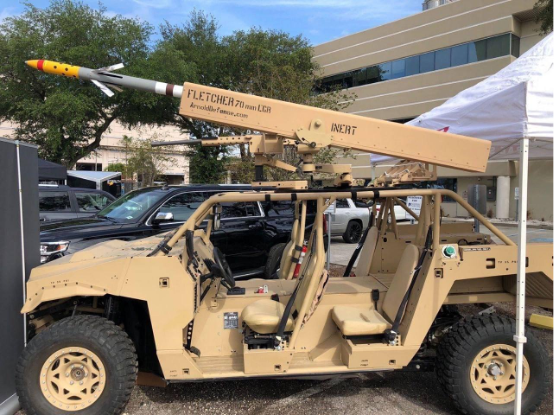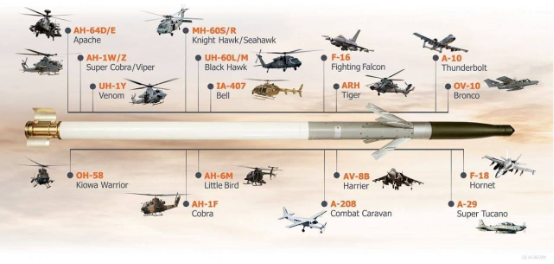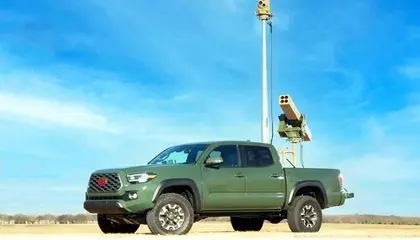The L3Harris Vehicle-Agnostic Modular Palletized ISR Rocket Equipment (VAMPIRE) is a newly-developed, portable kit that can be installed on most vehicles, with a cargo bed and can be fired by a single operator. It consists of a four-barrel pod from which it can launch the ‘Advanced Precision Kill Weapons System’ (APKWS), a 70mm laser-guided rocket.
A video, posted on the Оперативний ЗСУ (Operative AFU) Telegram channel on April 28, shows Ukrainian Marines from the 37th Marine Brigade firing three VAMPIRE rockets against Russian targets.
JOIN US ON TELEGRAM
Follow our coverage of the war on the @Kyivpost_official.
It then shows two missiles hitting buildings within a rural area close to a river, followed by a third shot of a rocket striking a sensor system installed on top of a steel observation tower overlooking probably, the same river.
The VAMPIRE system was promised to Kyiv by Washington almost a year ago and several news sites reported they would be delivered to Ukraine by the end of 2022.
The independent analytical group GeoConfirmed used open-source data to geolocate, the two strike locations depicted on the video, as the villages Korsunka and Kozachi Laheri, both villages on the left bank of the Dnipro River in the Kherson region currently occupied by Russian Federation (RF) forces.
Ukrainian open sources, regularly monitoring army activity, identified the launch vehicle as a US-supplied High Mobility Multipurpose Wheeled Vehicle (HMMWV) or an Oshkosh-manufactured mine-resistant armored vehicle. The authoritative commentator, with the Twitter handle Sergio, suggested the video confirmed the first use of the VAMPIRE launcher and APKWS by Ukraine on the battlefield.

Russian Attacks on Ukraine Energy Could Trigger ’Tipping Point’: UN
US officials in May 2022 announced plans to send Ukraine APKWS rockets, as part of an earlier, $22.6 million arms assistance package. The APKWS is a modernized version of a Vietnam-era 70mm “free-flight” Hydra rocket, retrofitted with a modern laser guidance system developed by the British company Bae Systems, which has been in use for almost a decade. The APKWS rocket has proved popular with NATO forces because of its accuracy, reliability and relatively low cost.
The AFU has not confirmed that the weapon used is VAMPIRE, but the projectile seen in the 30-second video looks consistent with the APKWS rocket in appearance, flight performance and size pf explosion of the warhead.
Limited by the size of its air force, compared to Russia’s, Ukraine has struggled to employ aircraft-launched weapons effectively on any scale. The version of VAMPIRE provided to Ukraine will allow them to take on both air and ground targets from the ground, rather than from the air.
Final funding for the VAMPIRE system was included as part of the August $2.98 billion arms and assistance package to Ukraine. The military monitoring publication Defense Post reported in August that VAMPIRE has an effective range of twelve kilometers and, because it is a laser-guided system, is immune to electronic jamming.
The first VAMPIRE systems were expected to be ready for use in Ukraine in May 2023, an Aug. 2022 Janes report said. An April 2023 article on the DefenseMirror.Com website quoted executives, from the American technology company Science Applications International Corporation (SAIC), as saying the US intends to provide ten systems to Ukraine, which could be used for defense against kamikaze drones. Tests carried out by SAIC in January reported that the APKWS rockets scored a 100 percent hit rate against test drones.

Image of a APKWS four-missile launcher installed on a military all-terrain vehicle.Image released by Armed Forces of Ukraine on Aug. 20.

Graphic showing NATO weapons systems capable of launching a Hydra rocket.UNIAN news agency image from May 10.
You can also highlight the text and press Ctrl + Enter






